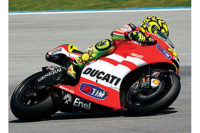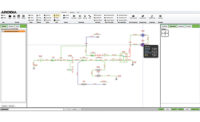Can the length of a wire harness routed in a wind turbine tower 394 feet tall and connected to a control cabinet in a nacelle be precisely determined by a computer? Yes, it can. Wind turbine manufacturer Nordex uses EPLAN software to do just that.
In Germany, wind turbines produce around 50 gigawatts of electricity, and turbines from the Nordex Group are responsible for a significant part of that output. The company is among the largest manufacturers of wind turbines worldwide. In its core European market, Nordex focuses on onshore turbines with an output of 2.4 to 4.5 megawatts. The turbines are designed to match the wind conditions where they are located. Options are available for low, medium and high wind speeds; different tower heights and rotor diameters; anti-icing systems; condition monitoring; and performance-enhancing features.
“We offer 15 to 20 options for each series. Then there are the differing regional requirements, such as for grid connection,” says Klaus Faltin, Ph.D., head of standards, data and PLM governance at Nordex.
The turbines are built at Nordex’s assembly plant in Rostock, Germany. Nacelles, rotor blades and control cabinets are assembled there, too. At any one time, up to 30 cabinets are moving from station to station on various assembly lines. “In addition to a center box, seven decentralized cabinets and control boxes for individual functions, such as yaw, azimuth and pitch drives, are installed in each nacelle housing,” says Wolfgang Conrad, head of the power distribution department at Nordex.
Engineers use EPLAN Software to design the cabinets. “Our goal is to get the most from EPLAN and to exploit the opportunities of standardized development and production as much as possible,” says Conrad.
Among other things, the software produces detailed bills of material and circuit diagrams. Every component, including screws, nuts and washers, is acquired and automatically assigned to projects. Any inconsistencies are detected immediately.
“If a part remains unassigned or has no location, it gets noticed immediately because all components are logically linked,” says Conrad.
This also applies to sheet metal processing for the control cabinets. “Previously, production personnel used templates for drilling patterns in control cabinets,” explains Enrico Durka, a senior engineer at Nordex. “Now, we generate a drilling pattern from EPLAN Pro Panel and send it as a DXF file straight to the processing machine.”
This has reduced internal delivery times for drilled control cabinets from several weeks to 48 hours.
Routing Wires
Nordex electrical engineers also use EPLAN Pro Panel and Smart Wiring software to create 3D mounting layouts and generate connection information from circuit diagrams. One benefit from this approach is wire-length determination using precision 3D routing. An electronic data record is then generated and sent to the harness assembler.
The positive experience from using EPLAN Pro Panel convinced Nordex engineers to use EPLAN Harness proD design software for harness engineering tasks, such as creating 3D models of the wiring throughout the tower and from the control cabinets.
“For example, the drivetrain is located in the nacelle’s middle, so the wire harnesses are routed on the inner rounded panels,” explains Martin Richter, an engineer responsible for wire harness design at Nordex. “It is therefore extremely challenging to determine lengths.”
Each cable is specified according to 16 parameters, including source, sink, control points and bend radii. Even the position of cable ties and grounding straps is precisely defined. “As a result, we benefit from having clear and consistent information about wire lengths, connector variants, labelling and other parts,” says Richter.
During implementation of EPLAN Harness proD, Nordex put samples to the test and compared engineers’ work with the output of the software.
“The task was to measure the nacelle housing of a prototype and determine the lengths of 50 cables running along the panels,” recalls Richter. “Two employees in production needed one day to determine exact measurements. Using EPLAN Harness proD, we needed just a third of the time.”
This result was reaffirmed in a similar test for a tower wire harness. “Here, 27 individual cables at a length of around 394 feet per phase required routing,” Richter continues. “Any miscalculations were in the low centimeter range. Routing tracks always fit precisely, and we don’t need to plan for extra cabling even for very long cables.”
Based on this experience, Nordex engineers have started to route cable ducts in the tower as source-target wiring right into the control cabinets.
With EPLAN, Nordex’s electrical engineers are nearing their goal of digitizing the entire wind turbine. “When we have a ‘digital mock-up’ of the system in the computer, we can act without a real prototype and directly produce an initial example for production,” says Faltin.
This is desirable because wind turbine systems are becoming increasingly complex. Today, more than 500 sensors could be installed in a single system. To prevent errors and increase efficiency, Nordex maintains a comprehensive database of every component used in a turbine. This includes 3D data models from the EPLAN Data Portal, which is updated continuously.




